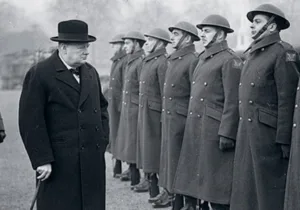“We attacked, I think, about 820 strong. A friend, an officer in ‘C’ Company, which was in support and shelled to pieces before it could start, told me in hospital that we lost 450 men that day, and that, after being put in again a day or two later, we had 54 left. I suppose it’s worth it.”
Thus wrote R. H. Tawney—then a sergeant in the Manchester Regiment, later the famous Anglican socialist—of his part in the British assault on the German trenches at the start of the Battle of the Somme. The casualties suffered on the first day, 1 July 1916, are infamous: 19,000 dead and 38,000 wounded. Less well known are the further 362,000 casualties piled up during the rest of the four-month battle. And the territorial gain for this appalling cost? An advance of six miles.
But territory alone does not measure the achievement. The British had attacked on the Somme partly to relieve the severe pressure on the French at Verdun, by forcing the enemy to re-deploy troops northwards. In this it succeeded.
Its main military aim, however, was to contribute to a concerted effort on both the Western and Eastern fronts to exhaust Germany’s reserves. In this it succeeded, too. If the Somme cost the Allies dearly, it also drained the Germans who, though defending, suffered over half a million casualties. One German officer described the Somme as “the muddy grave of the German Army”.
Still, whatever the strategic gains, the enormity of the human cost seems insupportable. The war against Wilhelmine Germany as a whole cost Britain and its empire over one million military deaths, and, compared to a body-count half the number in the longer war against Hitler, it looks criminally wasteful. But appearances deceive. Britain’s casualty figures in the war of 1939-45 were flattered by the fact that she never fought on the front decisive in breaking Hitler’s armies. That was in the east, where the Soviet Union suffered the deaths of almost eleven million troops (and even more civilians).
Further, the undisputed turning-point in the war against Hitler—the Battle of Stalingrad—was horrifically attritional, its human cost rivalling that of the battles of 1914-18. And on the mercifully few occasions in World War Two when British troops found themselves bogged-down in near-static fighting—hill-to-hill in Italy and hedge-to-hedge in Normandy—they reverted to the attritional tactics of 1917.
But weren’t the front-line lions led by top brass donkeys? Wasn’t British generalship in World War One incompetent, unimaginative, and callous? Certainly, a measure of incompetence was inevitable when British officers, trained to command small colonial forces, suddenly found themselves having to learn to manage millions. However, they were compelled to take the offensive against an invader at a stage of technological development that smiled upon defence, coming after the mass production of machine-guns but before the mass production of tanks and the development of the creeping artillery barrage and wireless communications. The United States was very fortunate indeed to stage its Civil War in the 1860s. Fifty years later, technology alone would have lifted its 600,000 fatal casualties into the several millions.
Far from being a boneheaded blimp, Douglas Haig, who presided over British planning for the Somme, was an early champion of the development of the tank. Nor was he heartless. Yes, he was highly professional: as Winston Churchill later wrote, he was like “a great surgeon before the days of anaesthetics: … intent upon the operation, entirely removed in his professional capacity from the agony of the patient…. He would operate without excitement … and if the patient died, he would not reproach himself”. Yet Haig was not insensible of the plight of his men. In the early days of the Somme his visits to the wounded in field hospitals so distressed him that his staff officers had to persuade him to stop. After the war, he devoted himself to the cause of war veterans through the British Legion.
Still, Haig did make a major strategic error in July 1916. But this was not that he settled unimaginatively for a prolonged slugfest of attrition; rather that he insisted on planning for a dramatic breakthrough. Consequently, British artillery-fire on the eve of battle was dissipated too deeply into the enemy’s defences, letting front-line German machine-gunners live to mow down the advancing Tommies. The tragic irony is that Haig was too bold, not too conservative, in his strategic ambition.
Notwithstanding the strategic gains and mitigating circumstances, we might still think the assault on the Somme an unjustifiable waste, because we doubt that Britain should have been fighting at all. After all, wasn’t the war simply a struggle for imperial dominance?
It was, but that doesn’t tell us much. Britain’s war against Hitler was also a fight for imperial dominance: we fought with our empire, and we fought to win. The important question is what moved us to fight.
In 1914, as in 1939, we went to war against a powerful rogue state that had trampled over international law and threatened international order. On 3 August 1914, Germany had launched an unprovoked attack on France, falsely claiming that French troops had crossed the border and French aircraft had bombed Nuremberg. At the same time she invaded Belgium, whose neutrality she was obliged by international treaty to guarantee. Britain had a moral obligation to aid France and a legal obligation to defend Belgium. She also had a perfectly legitimate national interest in preserving the Channel ports from hostile occupation.
The carnage one hundred years ago on the Somme was appalling. And because of Haig’s excessive strategic ambition, it was inefficiently appalling. But that didn’t make it futile. Tawney’s supposition was right.
—
Nigel Biggar is Regius Professor of Moral and Pastoral Theology, and Director of the McDonald Centre for Theology, Ethics, and Public Life, at the University of Oxford. He is the author of In Defence of War (Oxford: Oxford University Press, 2013) and, most recently, Between Kin and Cosmopolis: An Ethic of the Nation (Eugene, OR: Cascade, 2014).
Image Credit: Military artist drawing of the Battle of Delville Wood, The Somme, July 1916. First published in “The Great War”, Ed. H.W. Wilson, 1917. Via Wikimedia Commons.







 Live in the DC area? Sign-up for Providence's in-person events list!
Live in the DC area? Sign-up for Providence's in-person events list!